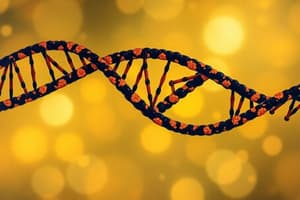Podcast
Questions and Answers
What can support the 'Theory of Evolution' according to DNA comparisons?
What can support the 'Theory of Evolution' according to DNA comparisons?
- All mutations are harmful.
- Common ancestors are always identical.
- Species can have no genes in common.
- Different species can share a common ancestor. (correct)
If two species share identical genes, they cannot be considered related.
If two species share identical genes, they cannot be considered related.
False (B)
What process occurs when one population becomes too different to reproduce with another population?
What process occurs when one population becomes too different to reproduce with another population?
Speciation
Mutations that enhance suitability for an environment may change some ______ but not all.
Mutations that enhance suitability for an environment may change some ______ but not all.
Match the following terms with their descriptions:
Match the following terms with their descriptions:
What is the result of comparing protein sequences between species?
What is the result of comparing protein sequences between species?
How do mutations in DNA relate to proteins?
How do mutations in DNA relate to proteins?
Flashcards are hidden until you start studying
Study Notes
Comparing DNA and the Theory of Evolution
- DNA comparison reveals genetic similarities, indicating potential common ancestry between species.
- Speciation occurs when populations diverge significantly and can no longer interbreed, leading to distinct species.
- Despite speciation, many genes and alleles may still be shared between the diverging species.
- Mutations can modify specific genes to enhance adaptability to new environments while retaining some shared genetic traits.
- The presence of identical or similar genes suggests a close evolutionary relationship, tracing back to a common ancestor.
Comparing Protein Sequences and Evolutionary Evidence
- DNA instructs the synthesis of proteins, essential for cellular functions and processes.
- Mutations in DNA sequences can lead to altered protein structures, producing new alleles of genes over generations.
- Accumulation of mutations over extended periods results in more pronounced differences between species, illustrating evolutionary divergence.
- Greater time since speciation typically correlates with increased genetic and protein sequence variability among organisms.
Studying That Suits You
Use AI to generate personalized quizzes and flashcards to suit your learning preferences.




